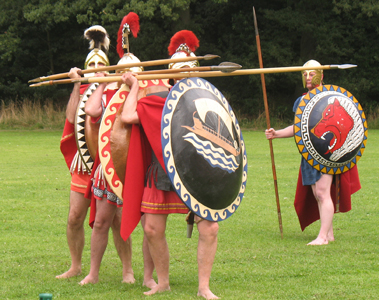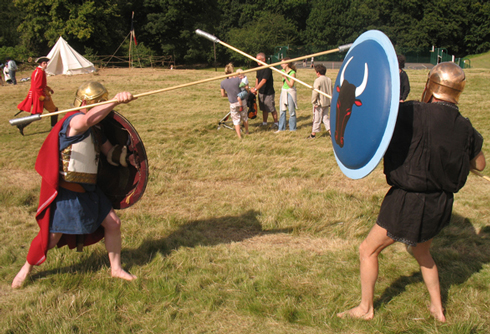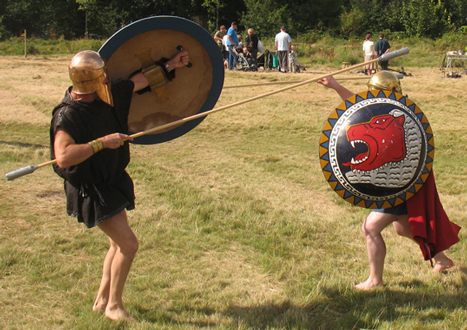How did hoplites fight?
The Phalanx
Hoplites usually fought in a battle formation called the phalanx. A phalanx was made up of ranks and files.
A rank was a row of hoplites, their shields held in their left hands and overlapping slightly. We see this in the reconstruction to the right. Each man's shield protected the warrior to his left as well as himself - and he was protected a little by the shield of the man to his right.
The spears were held in the right hand and at head height, and aimed forwards in the V shaped gap between the shields. This presented a formidable row of sharp points to the enemy. If the hoplites could maintain this tight formation, they were hard to beat.
A file was a row of hoplites standing behind each other. The typical phalanx was made up of 8 ranks - so each file was 8 men standing in front of each other. If the man at the front died, the man right behind him would take his place. If the enemy managed to get through all eight of the men in a file, then the army was in trouble. At this point often the army would lose heart and run away, dropping their heavy shields.
The picture right shows some hoplite re-enactors in a file. Notice that the spears of the men behind are held over the shoulders of those in front. They poked out enough to attack an enemy; so it was not only the men in the front rank who fought.
In fact because the spears were so long, a hoplite in the front rank might be aiming not at the enemy in front of him but at the one behind him. As you can imagine it was a very crowded, hot, and terrifying mass of spears thrusting backwards and forwards. Shields were pressed against shields, and each army by force of weight and muscle tried to shove the other side back, knocking them over, as well as killing them with their weapons.
The picture right shows a phalanx of four ranks from above. Note how the shields overlap.



Attack
As you can see from the pictures, the spear was mainly aimed at head height. An enemy's most vulnerable spot was usually his neck - his head probably had a helmet on, and his body was protected by a shield. The Persians only had leather caps and shields made of wicker - basically, thin twigs - so the Greeks were able to use get through these defences with their spears. As one re-enactor told me, fighting the Persians was like feeding them into a meat grinder.
As well as the neck, thighs were often exposed. An attack on the thigh would send a man to his knees, where he would easily be finished off.


If a spear broke or was lost, the hoplite would draw his sword. The spear was preferred, though, because it was very long and allowed you to strike an enemy further away. One disadvantage the Persians had against the Greek was their spears were shorter.
Defence
Hoplites were well protected by their armour, especially the shield. This was often held out at an angle, as we see in the picture above, in order to keep the enemy's weapon as far away as possible.
One danger was if an enemy thrust his spear at a hoplite's head. The hoplite had to be careful that if he raised his shield to protect himself, he didn't send the spear into his eyes. He had to completely cover his head with his shield.
The spears themselves could be used in defence. Look at the photos right of two hoplite re-enactors having a duel. The ends of their spears are padded for safety.

